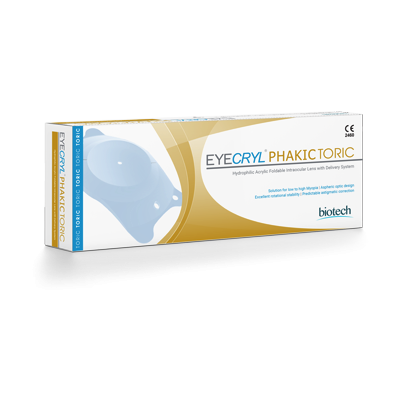Phakıc Lenses
Quick Links
No products found in this company category.
What are Phakic Lenses?
Phakic lenses, also known as Phakic Intraocular Lenses (PIOLs), serve as a revolutionary solution for correcting refractive errors without removing the natural lens. Unlike intraocular lenses used in cataract surgery, which replace the eye's crystalline lens, Phakic Lenses work in conjunction with the natural lens to correct refractive errors. They are typically made of biocompatible materials such as collamer, which minimizes the risk of rejection or adverse reactions. By precisely focusing light onto the retina, Phakic Lenses enable individuals to achieve clearer vision without relying on external visual aids like glasses or contact lenses.
What do Phakic Lenses do?
Phakic lenses, also known as Phakic Intraocular Lenses (PIOLs), correct refractive errors by refracting light rays entering the eye.
They compensate for conditions like myopia, hyperopia, and astigmatism by precisely focusing light onto the retina. Unlike intraocular lenses used in cataract surgery, Phakic Lenses work alongside the natural lens without replacing it. By altering the path of light, these lenses enable individuals to achieve clearer vision without relying on external visual aids such as glasses or contact lenses. Phakic Lenses are particularly beneficial for individuals with high degrees of refractive errors who may not be suitable candidates for corneal refractive surgery like LASIK or PRK. They offer predictable and stable vision correction while preserving the integrity of the natural lens. Thorough preoperative assessments and careful patient selection help ensure the safety and efficacy of Phakic Lens implantation, making it a valuable option for individuals seeking long-term freedom from refractive errors.
When Is Phakic Lenses Used?
Phakic lenses, or Phakic Intraocular Lenses (PIOLs), are employed when individuals exhibit refractive errors beyond the scope of conventional treatments like glasses, contact lenses, or corneal refractive surgery. Patients with high degrees of myopia or hyperopia, particularly those with thin corneas or irregular corneal shapes, often benefit from Phakic Lenses. They are particularly suitable for individuals who are not candidates for corneal refractive surgery, such as LASIK or PRK, due to thin corneas or high refractive errors. Additionally, patients who have undergone previous corneal surgeries or those with irregular corneal shapes may benefit from Phakic Lens implantation. Phakic Lenses provide a viable alternative for vision correction in these populations without compromising the natural accommodative capacity of the eye.
What are the side effects of Phakic Lenses?
While Phakic Lenses are generally safe and effective, they carry potential risks akin to any surgical procedure. Side effects may include increased intraocular pressures, retinal detachment, cataract formation, and other complications associated with intraocular surgery. However, with meticulous patient selection, thorough preoperative assessments, and skilled surgical techniques, the incidence of adverse events can be minimized.
What are the advantages of Phakic Lenses?
Phakic Lenses offer several advantages over alternative methods of refractive correction.
- Unlike corneal refractive surgeries like LASIK or PRK, Phakic Lenses preserve the integrity of the natural lens and cornea. This is particularly beneficial for patients with thin corneas or those who require high levels of refractive correction.
- The lenses provide predictable and stable vision correction, reducing the risk of postoperative complications such as dry eye syndrome or regression of visual acuity.
- Additionally, Phakic Lenses eliminate the inconvenience of daily maintenance associated with contact lenses. Patients who have undergone previous corneal surgeries or those with irregular corneal shapes may benefit from Phakic Lens implantation as an alternative to traditional vision correction methods.
- The customizable nature of Phakic Lenses allows for precise correction of refractive errors while accommodating individual anatomical characteristics, ensuring optimal visual outcomes for diverse patient populations.
After Which Surgery Should Phakic Lenses Be Used?
Phakic Lenses are particularly suitable for individuals who are not candidates for corneal refractive surgery, such as LASIK or PRK, due to thin corneas or high refractive errors. Additionally, patients who have undergone previous corneal surgeries or those with irregular corneal shapes may benefit from Phakic Lens implantation.
Intraocular Lens is Inappropriate for Which Age Group?
Intraocular lens (IOL) implantation is generally considered inappropriate for younger age groups, particularly those with flexible and accommodating crystalline lenses. This is because younger individuals typically have a higher degree of natural lens flexibility and accommodative capacity, allowing them to adjust focus for near and distance vision. Implanting an IOL in younger patients may compromise their ability to accommodate and may result in diminished near vision and reduced depth of field.
Additionally, younger patients may experience changes in their refractive error over time, which could necessitate additional surgical interventions to adjust the power of the implanted lens. Therefore, alternative vision correction methods may be more suitable for younger patients seeking refractive correction while preserving their natural accommodative function.
How long does a Phakic Lens last?
Phakic lenses are designed to be permanent implants, providing long-term vision correction for suitable candidates. With proper postoperative care and regular follow-up visits, Phakic Lenses can endure the rigors of daily activities and provide sustained visual clarity for many years. Regular follow-up appointments with an ophthalmologist are essential to monitor the condition of the Phakic Lens and address any potential issues that may arise, ensuring optimal visual outcomes for the patient over the long term.
Are Phakic Lenses Safe?
Phakic Lenses, including the Visian Implantable Collamer Lens (ICL – Visian ICL) and other PIOL implants, have undergone rigorous evaluation and received approval from the FDA for correcting refractive errors. While no surgical procedure is entirely devoid of risk, Phakic Lenses have demonstrated a high level of safety and efficacy in numerous clinical studies and real-world applications.
In Phakic Lens implantation, ophthalmologists measure the white to white distance, which is the horizontal span between the corneal scleral junctions. This measurement ensures proper sizing and alignment of the lens within the eye's anterior segment, minimizing the risk of postoperative complications.
Phakic Lens implantation is performed under local or topical anesthesia and involves making a small incision in the cornea or the sclera to introduce the lens into the anterior segment of the eye. Following surgery, patients undergo a period of postoperative care to monitor healing and ensure optimal visual outcomes. Regular follow-up visits with the ophthalmologist are essential to assess visual acuity, intraocular pressures, and the overall health of the eye. Adherence to established surgical protocols and thorough preoperative assessments are essential in ensuring optimal patient outcomes and minimizing potential complications.
Categories
Company
Media
Follow Us
© Copyright Biotech /Terms Of Use - Privacy Policy
Version 2_CT_1212222


